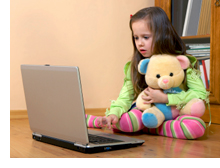August 26th, 2009
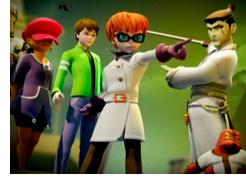
For those that follow my blog, you may remember a post I wrote last winter where I explored the world of children’s television commercials, just before and after the last holiday season. At the time my focus was mostly on the world of technology toys, and how toy companies promote their wares to children through television. Over eight consecutive weekends, I had watched about 100 hours of children’s television across seven stations, which loosely added up to over 3, 000 commercials viewed. That many commercials edited end-to-end would fill an entire day of watching nothing but commercials.
A couple of months ago I was reviewing the data I had collected, deciding if I might undertake a similar effort again this year (I’m looking for sponsors), when I realized I was sitting on a ton of stats related to virtual worlds and kids. After pulling my head out of the world of toys, and instead focusing on social and virtual worlds for kids, I realized that many virtual worlds were advertised for the first time ever on television during the latter part of 2008.
In the months leading up to last year’s Christmas holiday, at least nine virtual worlds were advertised in the US to older kids and younger tweens. These destinations included Bella Sara by Hidden City Games, Build-A-Bearville by Build-A-Bear Workshop, Mattel’s UB Funkeys, Cartoon Network’s Fusion Fall, Irwin Toy’s Me2 Universe, Disney’s Pixie Hollow, Hasbro’s MyEpets and LittlestPetShop, and Wizard 101 by KingsIsle Entertainment. Most companies offered commercial spots in 15 and 30 second lengths to promote their online virtual worlds. All commercials were placed on channels that aired children’s programming with the heaviest rotation appearing on weekends.
The company that had the most commercials in rotation was for Cartoon Network’s virtual world Fusion Fall. Cartoon Network ran an AMAZING number of spots in 10, 15, 30 and 45 second lengths to promote Fusion Fall, but all of Fusion Fall’s advertising was on a single channel, that being Cartoon Network. The shorter spots were placed strategically as bumpers around all show entry end exit points. I can’t cite the exact number, but the amount of Fusion Fall impressions per hour was impressive and more than any other competing site.
The Pixie Hollow and Wizard 101 virtual world commercials were the next heaviest in rotation after Fusion Fall, but for these worlds, they were advertised across multiple channels. Next in line was Build-A-Bearville, Bella Sara, and Funkeys. Each virtual world destination experienced an increase in unique visits to their virtual world but none more than Fusion Fall and Wizard 101 in the November to December 2008 time period. Both of these desitinations experienced an increase in web traffic 3 to 5 times more than before those on air campaigns began. All virtual worlds lost traffic to their sites after the holiday season as advertisement campaigns wound down, all except for Disney’s Pixie Hollow. However, gains remained for seven out of nine of the virtual worlds advertised when measured over a two month period, though only three out of the nine had experienced any significant gains. Out of the collection of these nine virtual worlds, seven companies offered a tangible product that was sold as part of their virtual world service.
Over the summer months, I’ve had the opportunity to check in on a few children’s channels to see what’s being advertised. A new crop of virtual world commercials are running on air this summer. One big surprise to me was MapleStory which is a virtual world that started outside the US. It makes sense to try to reach out to kids during these months to grow an audience base. I’ve been thinking that this might be a better and cheaper way to gain visibility as opposed to winning kids over during the winter holiday season.
Outside of children’s television, I’ve also been keeping a close watch on a number of virtual worlds for kids. Every now and then I’m surprised by how some site just explodes. Moshi Monsters has had my interest most of this summer. This is a UK virtual world for kids that has yet to take off here in the states, but has been doing great at home. I’ve wondered why it has been so successful in the last two months. Only recently did I came across an interview with Michael Smith, CEO for Moshi Monsters on YouTube. (Thanks Joi Podgorny for the tip!) In this interview Michael discusses the growth in visitors and subscribers to his site as a direct response to advertising on TV.
If you’re interested in learning more about the data I have, shoot me an email. One thing is certain though, we should all be prepared to see many more commercials of virtual world advertised to kids in the months, and years, ahead. What used to be a vital part of toy promotion is now expanding to the virtual world as well.


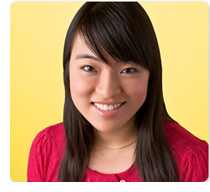

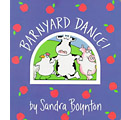 A delightful rhyming story of barnyard friends that go to a dance. The rhythm and meter of this story will keep you reciting sections from this book for days on end. Another great find for our family was discovering that there’s a Sandra Boynton CD available with this book’s lyrics set to song.
A delightful rhyming story of barnyard friends that go to a dance. The rhythm and meter of this story will keep you reciting sections from this book for days on end. Another great find for our family was discovering that there’s a Sandra Boynton CD available with this book’s lyrics set to song.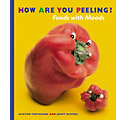 Elffers is a fantastic photographer with a talent for bringing personality and emotion out of common everyday fruits and vegetables. Each page is filled with wonderful facial expressions from his creations. Light copy, lots of unique and interesting faces to enjoy.
Elffers is a fantastic photographer with a talent for bringing personality and emotion out of common everyday fruits and vegetables. Each page is filled with wonderful facial expressions from his creations. Light copy, lots of unique and interesting faces to enjoy. Farmer Brown runs a no-nonsense farm, but things change once the cows who live there acquire an old typewriter and learn how to express there wishes on short notes. When Farmer Brown doesn’t comply with the cows requests, the cows decide they will go on strike. Fun, fun. fun!
Farmer Brown runs a no-nonsense farm, but things change once the cows who live there acquire an old typewriter and learn how to express there wishes on short notes. When Farmer Brown doesn’t comply with the cows requests, the cows decide they will go on strike. Fun, fun. fun!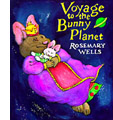 There are so many great books written by Rosemary Wells that it’s hard to pick even just a few, but the Bunny Planet books (a small collection of three books sold together as a set) have a wonderful Zen-like story quality to them. Ms. Wells explores the idea of a perfect world that lives inside our heads when things outside don’t go quite as well as we had planned.
There are so many great books written by Rosemary Wells that it’s hard to pick even just a few, but the Bunny Planet books (a small collection of three books sold together as a set) have a wonderful Zen-like story quality to them. Ms. Wells explores the idea of a perfect world that lives inside our heads when things outside don’t go quite as well as we had planned.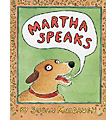 The story of a family dog named Martha who likes to eat alphabet soup. The interesting twist in the story is that when Martha eats the soup, the letters go up to her brain instead of down to her tummy! There are many Martha Speaks books available and the first is the one that sets up the story for the entire series.
The story of a family dog named Martha who likes to eat alphabet soup. The interesting twist in the story is that when Martha eats the soup, the letters go up to her brain instead of down to her tummy! There are many Martha Speaks books available and the first is the one that sets up the story for the entire series. I think everyone in the entire world loves Grover, the fuzzy blue character from Sesame Street. In this story, Grover asks, even begs, the reader not to turn the pages of this book because he’s afraid there’s a monster that might scare him on the very next page. You will read this one again and again with your young child.
I think everyone in the entire world loves Grover, the fuzzy blue character from Sesame Street. In this story, Grover asks, even begs, the reader not to turn the pages of this book because he’s afraid there’s a monster that might scare him on the very next page. You will read this one again and again with your young child.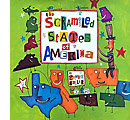 What would happen if each state in the nation could move to a new location? This book explores the fun and mayhem that ensues when each state moves to where they think they would really enjoy living. A funny story for children who are learning to memorize the US states.
What would happen if each state in the nation could move to a new location? This book explores the fun and mayhem that ensues when each state moves to where they think they would really enjoy living. A funny story for children who are learning to memorize the US states.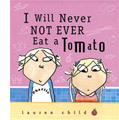 This is the first book that began the popular Charlie and Lola series of books and television shows. Lola is a very finicky eater. Her older brother Charlie presents familiar foods with funny names and stories that make Lola curious about what she might be missing. Just where do peas and fish sticks come from? And what sort of story would you tell to make eating these items more appealing?
This is the first book that began the popular Charlie and Lola series of books and television shows. Lola is a very finicky eater. Her older brother Charlie presents familiar foods with funny names and stories that make Lola curious about what she might be missing. Just where do peas and fish sticks come from? And what sort of story would you tell to make eating these items more appealing? The Owly book series are a charming collection of graphic novels starring an owl and his woodland friends. Together they go on many adventures, making new friends and helping other animals and friendly insects along the way. These books require a parent to imagine and invent the dialog alongside the visuals which I believe fosters an even closer story telling experience between reader and child.
The Owly book series are a charming collection of graphic novels starring an owl and his woodland friends. Together they go on many adventures, making new friends and helping other animals and friendly insects along the way. These books require a parent to imagine and invent the dialog alongside the visuals which I believe fosters an even closer story telling experience between reader and child.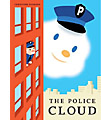 The graphic design approach to this story is just beautiful. Christoph Nieman is an artist for the New Yorker magazine and now shares his visual talents as a children’s book author. Nieman tells a captivating story about a cloud that wishes to become a policeman.
The graphic design approach to this story is just beautiful. Christoph Nieman is an artist for the New Yorker magazine and now shares his visual talents as a children’s book author. Nieman tells a captivating story about a cloud that wishes to become a policeman.
